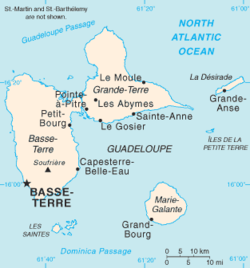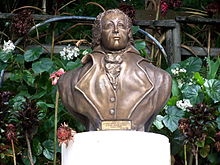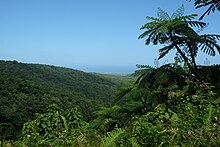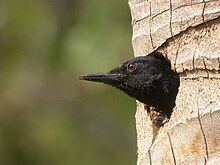
A | B | C | D | E | F | G | H | CH | I | J | K | L | M | N | O | P | Q | R | S | T | U | V | W | X | Y | Z | 0 | 1 | 2 | 3 | 4 | 5 | 6 | 7 | 8 | 9
Guadeloupe
Gwadloup (Guadeloupean Creole French) | |
|---|---|
| Anthem: La Marseillaise ("The Marseillaise") | |
 | |
 | |
| Coordinates: 16°15′N 61°30′W / 16.250°N 61.500°W | |
| Country | |
| Prefecture | Basse-Terre |
| Departments | 1 |
| Government | |
| • President of the Departmental Council | Guy Losbar[1] |
| • President of the Regional Council | Ary Chalus |
| Area | |
| • Total | 1,628 km2 (629 sq mi) |
| • Rank | 16th region |
| Highest elevation | 1,467 m (4,813 ft) |
| Population (Jan. 1, 2024)[2] | |
| • Total | 378,561 |
| • Density | 230/km2 (600/sq mi) |
| Demonym | Guadeloupean |
| GDP | |
| • Total | €9.462 billion |
| • Per capita | €22,500 |
| Time zone | UTC-4:00 (AST) |
| ISO 3166 code | |
| Largest metropolitan area | Pointe-à-Pitre |
| Currency | Euro (€) (EUR) |
| Website | www www |
Guadeloupe (/ˌɡwɑːdəˈluːp/; French: [ɡwad(ə)lup] ; Guadeloupean Creole French: Gwadloup, IPA: [ɡwadlup]) is an overseas department of France in the Caribbean.[4] It consists of six inhabited islands—Basse-Terre, Grande-Terre, Marie-Galante, La Désirade, and two Îles des Saintes—as well as many uninhabited islands and outcroppings.[5] It is south of Antigua and Barbuda and Montserrat and north of Dominica. The capital city is Basse-Terre, on the southern west coast of Basse-Terre Island; the most populous city is Les Abymes and the main centre of business is neighbouring Pointe-à-Pitre, both on Grande-Terre Island.[4] It had a population of 395,726 in 2024.[2]
Like the other overseas departments, it is an integral part of France. As a constituent territory of the European Union and the Eurozone, the euro is its official currency and any European Union citizen is free to settle and work there indefinitely, but is not part of the Schengen Area. It included Saint Barthélemy and Saint Martin until 2007, when they were detached from Guadeloupe following a 2003 referendum.
Christopher Columbus visited Guadeloupe in 1493 and gave the island its name. The official language is French; Antillean Creole is also spoken.[4][5]
Etymology

The archipelago was called Karukera (or "The Island of Beautiful Waters") by the native Arawak people.[4]
Christopher Columbus named the island Santa María de Guadalupe in 1493 after Our Lady of Guadalupe, a shrine to the Virgin Mary venerated in the Spanish town of Guadalupe, Extremadura.[4] When the area became a French colony, the Spanish name was retained - though altered to French orthography and phonology. The islands are locally known as Gwada.[6]
History
Pre-colonial era

The islands were first populated by indigenous peoples of the Americas, possibly as far back as 3000 BC.[7][8][9] The Arawak people are the first identifiable group, but they were later displaced c. 1400 by Kalina-Carib peoples.[4]
15th–17th centuries
Christopher Columbus was the first European to see Guadeloupe, landing in November 1493 and giving it its current name.[4] Several attempts at colonisation by the Spanish in the 16th century failed due to attacks from the native peoples.[4] In 1626, the French, under the trader and adventurer Pierre Belain d'Esnambuc, began to take an interest in Guadeloupe, expelling Spanish settlers.[4] The Compagnie des Îles de l'Amérique settled in Guadeloupe in 1635, under the direction of the French colonial leaders Charles Liénard de L'Olive and Jean du Plessis d'Ossonville; they formally took possession of the island for France and brought in French farmers to colonise the land. This led to the death of many indigenous people by disease and violence.[10] By 1640, however, the Compagnie des Îles de l'Amérique had gone bankrupt, and they thus sold Guadeloupe to Charles Houël du Petit Pré who began plantation agriculture, with the first African slaves arriving in 1650.[11][12] Slave resistance was immediately widespread, with an open uprising in 1656 lasting several weeks and a simultaneous spate of mass desertions that lasted at least two years until the French compelled indigenous peoples to stop assisting them.[13] Ownership of the island passed to the French West India Company before it was annexed to France in 1674 under the tutelage of their Martinique colony.[4] Institutionalised slavery, enforced by the Code Noir from 1685, led to a booming sugar plantation economy.[14]
18th–19th centuries
During the Seven Years' War, the British captured and occupied the islands until the 1763 Treaty of Paris.[4] During that time, Pointe-à-Pitre became a major harbour, and markets in Britain's North American colonies were opened to Guadeloupean sugar, which was traded for foodstuffs and timber. The economy expanded quickly, creating vast wealth for the French colonists.[15] So prosperous was Guadeloupe at the time that, under the 1763 Treaty of Paris, France forfeited its Canadian colonies in exchange for the return of Guadeloupe.[11][16] Coffee planting began in the late 1720s,[17] also worked by slaves and, by 1775, cocoa had become a major export product as well.[11]

The French Revolution brought chaos to Guadeloupe. Under new revolutionary law, freedmen were entitled to equal rights. Taking advantage of the chaotic political situation, Britain invaded Guadeloupe in 1794. The French responded by sending an expeditionary force led by Victor Hugues, who retook the islands and abolished slavery.[4] More than 1,000 French colonists were killed in the aftermath.[15]

In 1802, the French Consulate government reinstated the pre-revolutionary government and slavery, prompting a slave rebellion led by Louis Delgrès.[4] The French authorities responded quickly, culminating in the Battle of Matouba on 28 May 1802. Realising they had no chance of success, Delgrès and his followers committed mass suicide by deliberately exploding their gunpowder stores.[18][19] In 1810, the British captured the island again, handing it over to Sweden under the 1813 Treaty of Stockholm.[20]
In the 1814 Treaty of Paris, Sweden ceded Guadeloupe to France, giving rise to the Guadeloupe Fund. In 1815, the Treaty of Vienna acknowledged French control of Guadeloupe.[4][11]
Slavery was abolished in the French Empire in 1848.[4] After 1854, indentured labourers from the French colony of Pondicherry in India were brought in.[21] Emancipated slaves had the vote from 1849, but French nationality and the vote were not granted to Indian citizens until 1923, when a long campaign, led by Henry Sidambarom, finally achieved success.[22]
20th–21st centuries
In 1936, Félix Éboué became the first black governor of Guadeloupe.[23] During the Second World War Guadeloupe initially came under the control of the Vichy government, later joining Free France in 1943.[4] In 1946, the colony of Guadeloupe became an overseas department of France.[4]
Tensions arose in the post-war era over the social structure of Guadeloupe and its relationship with mainland France. The 'Massacre of St Valentine' occurred in 1952, when striking factory workers in Le Moule were shot at by the Compagnies républicaines de sécurité, resulting in four deaths.[24][25][26] In May 1967 racial tensions exploded into rioting following a racist attack on a black Guadeloupean, Raphael Balzinc,[27] resulting in eight deaths.[28][29][30]
An independence movement grew in the 1970s, prompting France to declare Guadeloupe a French region in 1974.[4] The Union populaire pour la libération de la Guadeloupe (UPLG) campaigned for complete independence, and by the 1980s the situation had turned violent with the actions of groups such as Groupe de libération armée (GLA) and Alliance révolutionnaire caraïbe (ARC).
Greater autonomy was granted to Guadeloupe in 2000.[4] Through a referendum in 2003, Saint-Martin and Saint Barthélemy voted to separate from the administrative jurisdiction of Guadeloupe, this being fully enacted by 2007.[4]
In January 2009, labour unions and others known as the Liyannaj Kont Pwofitasyon went on strike for more pay.[31] Strikers were angry with low wages, the high cost of living, high levels of poverty relative to mainland France and levels of unemployment that are amongst the worst in the European Union.[32] The situation quickly escalated, exacerbated by what was seen as an ineffectual response by the French government, turning violent and prompting the deployment of extra police after a union leader (Jacques Bino) was shot and killed.[33] The strike lasted 44 days and had also inspired similar actions on nearby Martinique. President Nicolas Sarkozy later visited the island, promising reform.[34] Tourism suffered greatly during this time and affected the 2010 tourist season as well.
Geography
This article or section may need to be cleaned up or summarized because it has been split from/to Geography of Guadeloupe. |



Guadeloupe is an archipelago of more than 12 islands, as well as islets and rocks situated where the northeastern Caribbean Sea meets the western Atlantic Ocean.[4] It is located in the Leeward Islands in the northern part of the Lesser Antilles, a partly volcanic island arc. To the north lie Antigua and Barbuda and the British Overseas Territory of Montserrat, with Dominica lying to the south.
The two main islands are Basse-Terre (west) and Grande-Terre (east), which form a butterfly shape as viewed from above, the two 'wings' of which are separated by the Grand Cul-de-Sac Marin, Rivière Salée and Petit Cul-de-Sac Marin. More than half of Guadeloupe's land surface consists of the 847.8 km2 Basse-Terre.[35] The island is mountainous, containing such peaks as Mount Sans Toucher (4,442 feet; 1,354 metres) and Grande Découverte (4,143 feet; 1,263 metres), culminating in the active volcano La Grande Soufrière, the highest mountain peak in the Lesser Antilles with an elevation of 1,467 metres (4,813 ft).[4][5] In contrast Grande-Terre is mostly flat, with rocky coasts to the north, irregular hills at the centre, mangrove at the southwest, and white sand beaches sheltered by coral reefs along the southern shore.[5] This is where the main tourist resorts are found.[36]
Marie-Galante is the third-largest island, followed by La Désirade, a north-east slanted limestone plateau, the highest point of which is 275 metres (902 ft). To the south lies the Îles de Petite-Terre, which are two islands (Terre de Haut and Terre de Bas) totalling 2 km2.[36]
Les Saintes is an archipelago of eight islands of which two, Terre-de-Bas and Terre-de-Haut are inhabited. The landscape is similar to that of Basse-Terre, with volcanic hills and irregular shoreline with deep bays.
There are numerous other smaller islands.
Geology
Basse-Terre is a volcanic island.[37] The Lesser Antilles are at the outer edge of the Caribbean Plate, and Guadeloupe is part of the outer arc of the Lesser Antilles Volcanic Arc. Many of the islands were formed as a result of the subduction of oceanic crust of the Atlantic Plate under the Caribbean Plate in the Lesser Antilles subduction zone. This process is ongoing and is responsible for volcanic and earthquake activity in the region. Guadeloupe was formed from multiple volcanoes, of which only La Grande Soufrière is not extinct.[38] Its last eruption was in 1976, and led to the evacuation of the southern part of Basse-Terre. 73,600 people were displaced throughout three and a half months following the eruption.
K–Ar dating indicates that the three northern massifs on Basse-Terre Island are 2.79 million years old. Sections of volcanoes collapsed and eroded within the last 650,000 years, after which the Sans Toucher volcano grew in the collapsed area. Volcanoes in the north of Basse-Terre Island mainly produced andesite and basaltic andesite.[39] There are several beaches of dark or "black" sand.[36]
La Désirade, east of the main islands, has a basement from the Mesozoic, overlaid with thick limestones from the Pliocene to Quaternary periods.[40]
Grande-Terre and Marie-Galante have basements probably composed of volcanic units of Eocene to Oligocene, but there are no visible outcrops. On Grande-Terre, the overlying carbonate platform is 120 metres thick.[40]
Climate
The islands are part of the Leeward Islands, so called because they are downwind of the prevailing trade winds, which blow out of the northeast.[4][5] This was significant in the days of sailing ships. Grande-Terre is so named because it is on the eastern, or windward side, exposed to the Atlantic winds. Basse-Terre is so named because it is on the leeward south-west side and sheltered from the winds. Guadeloupe has a tropical climate tempered by maritime influences and the Trade Winds. There are two seasons, the dry season called "Lent" from January to June, and the wet season called "winter", from July to December.[4]
| Climate data for Guadeloupe | |||||||||||||
|---|---|---|---|---|---|---|---|---|---|---|---|---|---|
| Month | Jan | Feb | Mar | Apr | May | Jun | Jul | Aug | Sep | Oct | Nov | Dec | Year |
| Mean daily maximum °C (°F) | 29.1 (84.4) |
29.1 (84.4) |
29.4 (84.9) |
30.1 (86.2) |
30.7 (87.3) |
31.3 (88.3) |
31.5 (88.7) |
31.6 (88.9) |
31.5 (88.7) |
31.2 (88.2) |
30.5 (86.9) |
29.6 (85.3) |
30.5 (86.9) |
| Daily mean °C (°F) | 24.5 (76.1) |
24.5 (76.1) |
24.9 (76.8) |
25.9 (78.6) |
26.9 (80.4) |
27.5 (81.5) |
27.6 (81.7) |
27.7 (81.9) |
27.4 (81.3) |
27.0 (80.6) |
26.3 (79.3) |
25.2 (77.4) |
26.3 (79.3) |
| Mean daily minimum °C (°F) | 19.9 (67.8) |
19.9 (67.8) |
20.4 (68.7) |
21.7 (71.1) |
23.1 (73.6) |
23.8 (74.8) |
23.8 (74.8) |
23.7 (74.7) |
23.3 (73.9) |
22.9 (73.2) |
22.1 (71.8) |
20.9 (69.6) |
22.1 (71.8) |
| Average precipitation mm (inches) | 84 (3.3) |
64 (2.5) |
73 (2.9) |
123 (4.8) |
148 (5.8) |
118 (4.6) |
150 (5.9) |
198 (7.8) |
236 (9.3) |
228 (9.0) |
220 (8.7) |
137 (5.4) |
1,779 (70.0) |
| Average precipitation days | 15.0 | 11.5 | 11.5 | 11.6 | 13.6 | 12.8 | 15.4 | 16.2 | 16.6 | 18.1 | 16.6 | 15.7 | 174.6 |
| Mean monthly sunshine hours | 235.6 | 229.1 | 232.5 | 240.0 | 244.9 | 237.0 | 244.9 | 248.0 | 216.0 | 217.0 | 207.0 | 223.2 | 2,775.2 |
| Source: Hong Kong Observatory[41] | |||||||||||||

Tropical cyclones and storm surges
Located in a very exposed region, Guadeloupe and its dependencies have to face many cyclones. The deadliest hurricane to hit Guadeloupe was the Pointe-à-Pitre hurricane of 1776, which killed at least 6,000 people.[42]
In 1989, Hurricane Hugo caused severe damage to the islands of the archipelago and left a deep mark on the memory of the local inhabitants. In 1995, three hurricanes (Iris, Luis and Marilyn) hit the archipelago in less than three weeks. Other notable hurricanes include Okeechobee in 1928, Betsy in 1965, Cleo in 1964, Inez in 1966, and Irma and Maria in 2017.
Flora

With fertile volcanic soils, heavy rainfall and a warm climate, vegetation on Basse-Terre is lush.[35] Most of the island's forests are on Basse-Terre, containing such species as mahogany, ironwood and chestnut trees.[4] Mangrove swamps line the Salée River.[4] Much of the forest on Grande-Terre has been cleared, with only a few small patches remaining.[4]
Between 300 and 1,000 metres (980 and 3,280 ft) of altitude, the rainforest that covers a large part of the island of Basse-Terre develops. Vegetation there includes the white gum tree, the acomat-boucan or chestnut tree, the marbri or bois-bandé or the oleander; shrubs and herbaceous plants such as the mountain palm, the balisier or ferns; many epiphytes: bromeliads, philodendrons, orchids and lianas. Above 1,000 m (3,300 ft), the humid savannah develops, composed of mosses, lichens, sphagnum or more vigorous plants such as mountain mangrove, high altitude violet or mountain thyme.
The dry forest occupies a large part of the islands of Grande-Terre, Marie-Galante, Les Saintes, La Désirade and also develops on the leeward coast of Basse-Terre. The coastal forest is more difficult to develop because of the nature of the soil (sandy, rocky), salinity, sunshine and wind and is the environment where the sea grape, the mancenilla (a very toxic tree whose trunk is marked with a red line), the icaquier or the Coconut tree grow. On the cliffs and in the Arid zones are found cacti such as the cactus-cigar (Cereus), the prickly pear, the chestnut cactus, the "Tête à l'anglais" cactus and the aloes.
The Mangrove forest that borders some of Guadalupe's coasts is structured in three levels, from the closest to the sea to the farthest. On the first level are the red mangroves; on the second, about 10 metres (33 ft) from the sea, the black mangroves form the shrubby mangrove; on the third level the white mangroves form the tall mangrove. Behind the mangrove, where the tide and salt do not penetrate, a swamp forest sometimes develops, unique in Guadeloupe. The representative species of this environment is the Mangrove-medaille.

Fauna
Few terrestrial mammals, aside from bats and raccoons, are native to the islands. The introduced Javan mongoose is also present on Guadeloupe.[4] Bird species include the endemic purple-throated carib and the Guadeloupe woodpecker.[4] The waters of the islands support a rich variety of marine life.[4]
However, by studying 43,000 bone remains from six islands in the archipelago, 50 to 70% of snakes and lizards on the Guadeloupe Islands became extinct after European colonists arrived, who had brought with them mammals such as cats, mongooses, rats, and raccoons, which might have preyed upon the native reptiles.[43]
Environmental preservation
In recent decades, Guadeloupe's natural environments have been affected by hunting and fishing, forest retreat, urbanization and suburbanization. They also suffer from the development of intensive crops (banana and sugar cane, in particular), which reached their peak in the years 1955–75. This has led to the following situation: seagrass beds and reefs have degraded by up to 50% around the large islands; mangroves and mantids have almost disappeared in Marie-Galante, Les Saintes and La Désirade; the salinity of the fresh water table has increased due to "the intensity of use of the layer"; and pollution of agricultural origin (pesticides and nitrogenous compounds).[44]
In addition, the ChlEauTerre study, unveiled in March 2018, concludes that 37 different anthropogenic molecules (more than half of which come from residues of now-banned pesticides, such as chlordecone) were found in "79% of the watersheds analyzed in Grande-Terre and 84% in Basse-Terre." A report by the Guadeloupe Water Office notes that in 2019 there is a "generalized degradation of water bodies."
Despite everything, there is a will to preserve these environments whose vegetation and landscape are preserved in some parts of the islands and constitute a sensitive asset for tourism. These areas are partially protected and classified as ZNIEFF, sometimes with nature reserve status, and several caves are home to protected chiropterans.

The Guadalupe National Park was created on 20 February 1989. In 1992, under the auspices of UNESCO, the Biosphere Reserve of the Guadeloupe Archipelago (Réserve de biosphère de l'archipel de la Guadeloupe) was created. As a result, on 8 December 1993, the marine site of Grand Cul-de-sac was listed as a wetland of international importance.[45] The island thus became the overseas department with the most protected areas.
Earthquakes and tsunamis
The archipelago is crossed by numerous geological faults such as those of la Barre or la Cadoue, while in depth, in front of Moule and La Désirade begins the Désirade Fault, and between the north of Maria-Galante and the south of Grande-Terre begins the Maria Galante Fault. And it is because of these geological characteristics, the islands of the department of Guadeloupe are classified in zone III according to the seismic zoning of France and are subject to a specific risk prevention plan.[46]
The 1843 earthquake in the Lesser Antilles is, to this day, the most violent earthquake known. It caused the death of more than a thousand people, as well as major damage in Pointe-à-Pitre.
On 21 November 2004, the islands of the department, in particular Les Saintes archipelago, were shaken by a violent earthquake that reached a magnitude of 6.3 on the Richter scale and caused the death of one person, as well as extensive material damage.[47]
Demographics
Graphs are unavailable due to technical issues. There is more info on Phabricator and on MediaWiki.org. |
| Year | Pop. | ±% p.a. |
|---|---|---|
| 1954 | 223,675 | — |
| 1961 | 276,545 | +2.96% |
| 1967 | 305,312 | +1.66% |
| 1974 | 315,848 | +0.49% |
| 1982 | 317,269 | +0.06% |
| 1990 | 353,431 | +1.36% |
| 1999 | 386,566 | +1.00% |
| 2010 | 403,355 | +0.39% |
| 2015 | 397,990 | −0.27% |
| 2021 | 384,315 | −0.58% |
| 2024 | 378,561 | −0.50% |
| Source: INSEE[48] | ||
Guadeloupe recorded a population of 378,561 according to Jan. 1, 2024 estimates.[2] The population is mainly Afro-Caribbean. European, Indian (Tamil, Telugu, and other South Indians), Lebanese, Syrians, and Chinese are all minorities. There is also a substantial population of Haitians in Guadeloupe who work mainly in construction and as street vendors.[49] Basse-Terre is the political capital; however, the largest city and economic hub is Pointe-à-Pitre.[4]
The population of Guadeloupe has been decreasing by 0.8% per year since 2013.[50] In 2017 the average population density in Guadeloupe was 240 inhabitants per square kilometre (620/sq mi), which is very high in comparison to metropolitan France's average of 119 inhabitants per square kilometre (310/sq mi).[51] One third of the land is devoted to agriculture and all mountains are uninhabitable; this lack of space and shelter makes the population density even higher.
Major urban areas
The most populous urban unit (agglomeration) is Pointe-à-Pitre-Les Abymes, which covers 11 communes and 65% of the population of the department.[52] The three largest urban units are:[53]
| Urban unit | Population (2019) |
|---|---|
| Pointe-à-Pitre-Les Abymes | 249,815 |
| Basse-Terre | 50,104 |
| Capesterre-Belle-Eau | 25,362 |
Health
In 2011, life expectancy at birth was recorded at 77.0 years for males and 83.5 for females.[54]
Medical centres in Guadeloupe include: University Hospital Centre (CHU) in Pointe-à-Pitre, Regional Hospital Centre (CHR) in Basse-Terre, and four hospitals located in Capesterre-Belle-Eau, Pointe-Noire, Bouillante and Saint-Claude.[circular reference][55]
The Institut Pasteur de la Guadeloupe, is located in Pointe-à-Pitre and is responsible for researching environmental hygiene, vaccinations, and the spread of tuberculosis and other mycobacteria.[56]
Immigration
The relative wealth of Guadeloupe contrasts with the extreme poverty of several islands in the Caribbean region, which makes the community an attractive place for the populations of some of these territories.[57] In addition, other factors, such as political instability and natural disasters, explain this immigration. As early as the 1970s, the first illegal immigrants of Haitian origin arrived in Guadeloupe to meet a need for labour in the agricultural sector; alongside this Haitian immigration, which is more visible because it is more numerous, Guadeloupe has also seen the arrival and settlement of populations from the island of Dominica and the Dominican Republic. In 2005, the prefecture, which represents the State in Guadeloupe, reported figures of between 50,000 and 60,000 foreigners in the department.[58]

Migration
Created in 1963 by Michel Debré, Bumidom's objective was to " contribute to the solution of demographic problems in the overseas departments". To this end, its missions were multiple: information for future emigrants, vocational training, family reunification and management of reception centres. At the time, this project was also seen as a means to diminish the influence of the West Indian independence movements, which were gaining strength in the 1960s.[59]
Between 1963 and 1981, an estimated 16,562 Guadeloupeans emigrated to metropolitan France through Bumidom. And the miniseries Le Rêve français (The French Dream) sets out to recount some of the consequences of the emigration of West Indians and Reunionese to France.
An estimated 50,000 Guadeloupeans and Martinicans participated in the construction of the Panama Canal between 1904 and 1914. In 2014, it was estimated that there were between 60,000 and 70,000 descendants of these West Indians living in Panama.[60] Other waves of migration to North America, especially to Canada, occurred at the beginning of the 20th century.
Governance
Together with Martinique, La Réunion, Mayotte and French Guiana, Guadeloupe is one of the overseas departments, being both a region and a department.[4] It is also an outermost region of the European Union. The inhabitants of Guadeloupe are French citizens with full political and legal rights.

Legislative powers are centred on the separate departmental and regional councils.[4] The elected president of the Departmental Council of Guadeloupe is currently Guy Losbar (1.7.2021); its main areas of responsibility include the management of a number of social and welfare allowances, of junior high school (collège) buildings and technical staff, and local roads and school and rural buses. The Regional Council of Guadeloupe is a body, elected every six years, consisting of a president (currently Ary Chalus) and eight vice-presidents. The regional council oversees secondary education, regional transportation, economic development, the environment, and some infrastructure, among other things.
Guadeloupe elects one deputy from one of each of the first, second, third, and fourth constituencies to the National Assembly of France. Three senators are chosen for the Senate of France by indirect election.[4] For electoral purposes, Guadeloupe is divided into two arrondissements (Basse-Terre and Pointe-à-Pitre), and 21 cantons.
Most of the French political parties are active in Guadeloupe. In addition there are also regional parties such as the Guadeloupe Communist Party, the Progressive Democratic Party of Guadeloupe, the Guadeloupean Objective, the Pluralist Left, and United Guadeloupe, Solidary and Responsible.
The prefecture (regional capital) of Guadeloupe is Basse-Terre. Local services of the state administration are traditionally organised at departmental level, where the prefect represents the government.[4]
Administrative divisions
For the purposes of local government, Guadeloupe is divided into 32 communes.[4] Each commune has a municipal council and a mayor. Revenues for the communes come from transfers from the French government, and local taxes. Administrative responsibilities at this level include water management, civil register, and municipal police.


